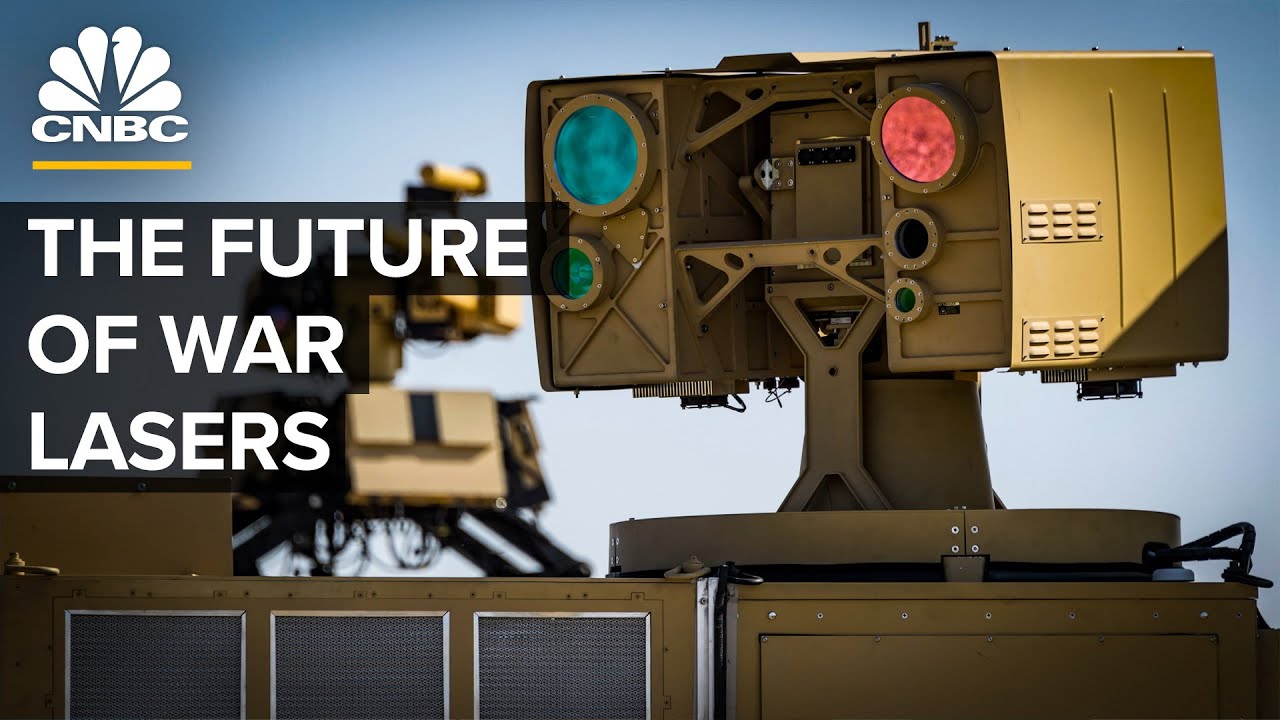The US is in an almost
invisible arms race. The Defense Department
has spent over $1 billion Annually to develop
direct energy weapons, Lasers and microwave
weapons. In other words, we're. Focusing on missions that
can't really be handled Very well with
traditional weapons Systems. In July 2023, the US Army
awarded a contract worth $221 million to Lockheed
Martin to develop a high Energy laser system
designed to defend against Aerial threats. Lasers
have been used by the Military since the Cold
War. Most lasers have been
used for targeting or Illumination.
Illumination can be used With some sensors, such
as night vision, to point Out enemy locations. Laser designation creates
a laser reflection on a Point that a bomb or
missile can hone in on, But now lasers can take
out rockets and drones by Focusing kilowatts of
power on a precise point. Lasers can overheat,
redirect, destroy, and Damage targets, causing
them to be ineffective. Recent advances in drone
and cruise missile Technology have made the
ability to cheaply Intercept these small
targets more important. The people I talk to, they
say, you know, we're in a Good place right now for
directed energy. It's out there on ships. The Army's testing it. Air force is testing it
with with Thor, for Example. But there's
still a ways to go. In fiscal 2023, they
requested 670 ish million For unclassified research
and testing, and then
About 345 million for
unclassified procurement Fiber lasers, which are
kind of the state of the Art for air. Defense lasers right now,
which is essentially the Same kind of laser you
might use for a welding System or a cutting
system that's used Industrially. Russia and China are
working on their own laser Weapons, and Russia
claims to have used theirs Against Ukrainian drones
with missiles, rockets and Drones taking over modern
warfare. The military laser may
leave the pages of science Fiction and play a big
role on the battlefield of The future. There are many different
kinds of lasers. Laser is an acronym for
Light Amplification by Stimulated Emission of
Radiation. In the past, the US
military has experimented With chemical lasers. These require large
volumes of dangerous Chemicals to create the
reactions needed to output A powerful laser. The US
Air Force tested the Airborne laser in the 90s
and early 2000, which was A modified 747 to shoot
down missiles as they Launched. The program
cost around $5 billion Over 16 years before it
was canceled. Solid state lasers,
although complex, have Fewer moving parts and do
not need large quantities Of chemicals to generate
power. Directed energy weapons
like ion beam come in two Forms. Typically that's
high power microwave and High energy laser. Agl. Agl basically just
focuses a beam or beams of Energy to cut, melt,
inflict heat damage on
Whatever target you want. But because it takes time
to inflict that damage, it Does have some issues
with. You have to stay on
target. You have to Maintain that, but it
doesn't need a manual Reload like a rifle or a
tank. You can just rely on
power and that's referred To as unlimited magazine
depth. They also have legal
hurdles to contend with. You know, under current
interpretations of International law, laser
weapons are generally not Considered usable against
people, so directly Against people. So you
can use them against a Platform, you can use
them against weapons, but Using them as an
anti-personnel weapon is Considered to be illegal. The US Army, Navy, Marines
and Air Force are all Testing, fielding or
researching new ways to Use lasers. We're going to start with
100 kilowatt class lasers And then scale the powers
the beam powers up and the Beam directors and
everything else. You need to get those
beams on target up over Time to first handle
these these kinds of drone Missions and then move
into cruise missile Threats and then finally
into strategic missile Threats. So you might
think, you know, ballistic Missiles, hypersonic
weapons and the like. The Air Force has
considered lasers for Fighters, the Army as
part of short range air Defense, the Navy as a
way to take on drones and Small boats, among other
Defense Department needs. And as these high powered
lasers move from testing To operations, the
Defense Department will
Likely find more uses for
these high tech tools. During the last two
decades, Israel has Developed a system to
intercept small and Mid-range rockets
launched by armed groups Such as Hamas. Designed really to focus
on relatively short range Missiles, mortars and
unmanned air vehicles at Ranges up to about 20 or
30km. The Iron Dome system,
designed and built by Rafael Advanced Defense
Systems and Israel Aerospace Industries, and
working with the help of Raytheon in the US. In
the case of some missile Production, launches a
missile that intercepts Rockets in mid-air. It's also affected because
it's able to use initially Just algorithms, and now
AI enabled algorithms to Figure out and predict
where the incoming threats Are likely to land, and
determine whether they are Constitute something that
needs to shoot down or Not. So if an incoming
missile, for example, or a Rocket is going to hit an
uninhabited area, Iron Dome will ignore it and
focus its attention on Those threats that are
likely to hit a populated Area or a target it's
trying to protect. The system must detect and
launch in a matter of Seconds to successfully
intercept a target. The cost of each
interceptor is enormous Compared to the cost of
the rocketed intercepts, Which is one reason
Israel has pushed for the Ion beam system. Each shot by the iron
beam costs only dollars, But the system is still
in development. The iron beam also uses a
novel method, in which Multiple laser beams are
used in unison to increase
Power on target. However,
the laser can be hindered By weather, and it has a
relatively short range, Which means that it works
better alongside the Iron Dome as a complete system
rather than by itself. The cost of the system is
only $2 per interception Compared with the Iron
Dome, which costs around $50,000 per interceptor. Now, the. Iron beam system is not
operational yet, so it's Expected to be
operational later this Year or early next year. So it's not yet being
used in the Israel-hamas Conflict right now, but
it's expected to be or Planned to be a 100
kilowatt laser, which is About the minimum size
you need in order to be Able to shoot down a
rocket or a missile. The US military has
fielded close in weapon Systems to target rockets
and mortar rounds for Years. C-ram or
Counter-rocket Artillery And Mortar, which is a
land based version of a Sea oriented system used
by the Navy, was utilized In Iraq and Afghanistan
to take down small threats To US troops, but the
cost of thousands of Rounds of 20 millimeter
ammunition can add up Quickly, which is one
reason the US Army has Looked into lasers for
short range air defense. The Navy has started
fielding a system called Helios, which stands for
High Energy Laser with Integrated optical
dazzler and surveillance, And it costs around 100
million for the initial Production and testing
and integration of the First devices. The current generation of
US Navy destroyers will Carry Helios, and that's
probably about the most
They can power on a
continuous basis and cool On a continuous basis. The flight three
destroyers that are being Built now have more spare
power capacity, and so the Idea would be they're
going to be supporting 150 To 300 kilowatt laser
within their own power Capacity and cooling
capacity. The Air Force is looking
at a mobile laser called H 4, the early prototypes
cost around $13 million Each. But the big
savings, like with ion Beam, is in the cost per
intercept, which is quite Low compared to bullets
or missiles. And the Army is using
lasers for its short range Air defense mission, the
D m Shorad, or Direct Energy Maneuver short
range air defense Vehicle, Can use a laser system to
take out drones, and these Weapons performed a live
fire exercise earlier this Year at the Yuma Testing
Grounds, which is to say That laser weapons aren't
around the corner. They're already here. Like any new system, the
more you use it, the more You learn about what it
can and can't do on the Battlefield. And getting
high energy lasers into The real world of
military operations is the First step towards
figuring out how best to Use them. You know, when we're
talking about these ground Applications, I could
speculate all day about What they could be useful
for or what they might not Be useful for. But the thing that's
missing is campaigning, Getting them in, you
know, getting them onto an Aircraft and testing,
testing them out in these Missions. And then once
you're testing them out
And you're figuring out
whether they work, you Know, whether you can do
maintenance on this laser Beam director window in
the field. When you can figure those
things out, then you can Transition them into a
full on program. High powered microwaves
are another type of direct Energy weapon that could
be useful in future Fights. And a lot. Of the counter-drone
systems you see use a high Power microwave. So drone
zappers, etcetera to Disrupt or damage the
electronics on a on a Drone. So high power
microwave can be very Effective and it requires
less time on target. So you can do that in
milliseconds. You can Disrupt the electronics
and force a drone, for Example, to reboot. And
it causes it to lose its Mission and has to turn
home or something. So you're seeing, you
know, high power Microwaves making its way
into air defense missions. But there's this concern
about fratricide and the Beamwidth, and that's
something that they'll Have to engineer out. But I think it's worth
noting that that's another That's an alternative
form of directed energy. How industry responds to
the current geopolitical Climate could shape how
the military allocates Future budgetary
resources, and making Lasers a priority means
that they will have more Support from users and
producers. I was at a defense
conference here in DC, and Admiral Aquilino, the
Indopacom boss, was on Stage and was was asked
about, you know, directed Energy in its future
applications. And he word For word said, bring it.
He wants to see what's
out there. He wants to see how he
can test them, apply them To the Indo-Pacific,
which is obviously the Biden administration's
big overarching goal. You know, current events
aside, and I think Industry has taken that
and is listening. I think it'll be
interesting to watch how Directed energy is
applied in the Indo-Pacific, especially
because you come across Issues of distance and
weather when you start Talking about directed
energy. And that obviously Looks way different than
the Middle East or Europe Or something like that.





